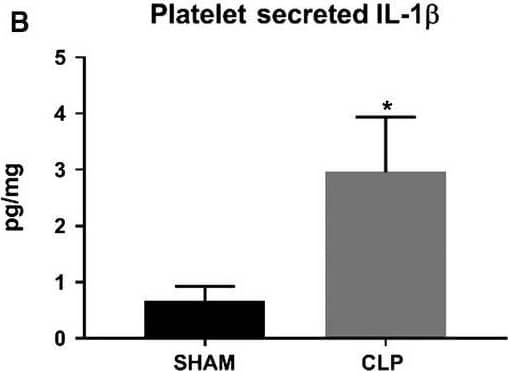Rat IL-1 beta/IL-1F2 Quantikine ELISA Kit Best Seller
R&D Systems, part of Bio-Techne | Catalog # RLB00

Key Product Details
Assay Length
Sample Type & Volume Required Per Well
Sensitivity
Assay Range
Product Summary for Rat IL-1 beta/IL-1F2 Quantikine ELISA Kit
Product Specifications
Assay Type
Format
Measurement
Detection Method
Conjugate
Reactivity
Specificity
Cross-reactivity
Interference
Precision
Intra-Assay Precision (Precision within an assay) Three samples of known concentration were tested on one plate to assess intra-assay precision.
Inter-Assay Precision (Precision between assays) Three samples of known concentration were tested in separate assays to assess inter-assay precision.
Cell Culture Supernates, EDTA Plasma, Serum
| Intra-Assay Precision | Inter-Assay Precision | |||||
|---|---|---|---|---|---|---|
| Sample | 1 | 2 | 3 | 1 | 2 | 3 |
| n | 20 | 20 | 20 | 20 | 20 | 20 |
| Mean (pg/mL) | 83.4 | 253 | 610 | 82.3 | 249 | 626 |
| Standard Deviation | 7.3 | 9.9 | 24 | 4.7 | 10.3 | 27 |
| CV% | 8.8 | 3.9 | 3.9 | 5.7 | 4.1 | 4.4 |
Recovery for Rat IL-1 beta/IL-1F2 Quantikine ELISA Kit
The recovery of rat IL-1 beta spiked to three levels throughout the range of the assay in various matrices was evaluated.
| Sample Type | Average % Recovery | Range % |
|---|---|---|
| Cell Culture Supernates (n=5) | 100 | 89-110 |
| EDTA Plasma (n=5) | 98 | 89-111 |
| Serum (n=5) | 108 | 97-120 |
Linearity
To assess the linearity of the assay, five or more samples spiked with various concentrations of rat IL-1 beta in each matrix were diluted with Calibrator Diluent and then assayed.

Scientific Data Images for Rat IL-1 beta/IL-1F2 Quantikine ELISA Kit
Rat IL-1 beta/IL-1F2 ELISA Standard Curve
Rat IL-1 beta/IL-1F2 Quantikine ELISA Kit
Platelet caspase 1 activity and IL‐1 beta secretion in response to CLP. Caspase 1 activity (A) was measured in platelet homogenates obtained from CLP and Sham rats. IL‐1 beta concentration (B) was measured in conditioned media from CLP and Sham rat platelets via ELISA. *P 0.05 versus Sham. Image collected and cropped by CiteAb from the following open publication (https://pubmed.ncbi.nlm.nih.gov/31054188), licensed under a CC-BY license. Not internally tested by R&D Systems.Preparation and Storage
Shipping
Stability & Storage
Background: IL-1 beta/IL-1F2
Long Name
Alternate Names
Entrez Gene IDs
Gene Symbol
Additional IL-1 beta/IL-1F2 Products
Product Documents for Rat IL-1 beta/IL-1F2 Quantikine ELISA Kit
Product Specific Notices for Rat IL-1 beta/IL-1F2 Quantikine ELISA Kit
For research use only
⚠ WARNING: This product can expose you to chemicals including N,N-Dimethylforamide, which is known to the State of California to cause cancer. For more information, go to www.P65Warnings.ca.gov.

